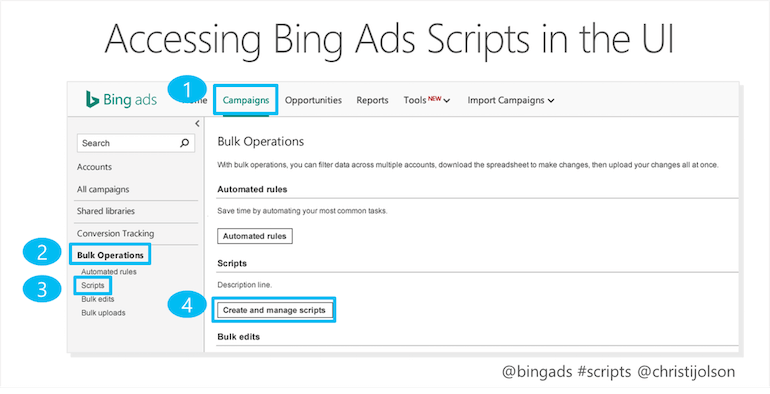Work Smarter, Not Harder, With Bing Ads Scripts

Feeling crunched for time? Consider automating some of your more tactical and time-consuming tasks. If you aren’t already using scripts to manage campaigns, then you need to take a serious look. In case you’re unfamiliar with them, scripts—i.e., snippets of JavaScript—are part of the Google Ads and Bing Ads search interfaces and allow you to use JavaScript to automate processes and tasks within your PPC accounts.
These little bits of code are big game changers because they can enhance your campaigns and save you tons of time. They automate time-consuming tasks like moving budget across campaign-based budget caps and performance. They also do the work that no search marketer has time to do manually, such as checking for 404 pages and pausing ads for out-of-stock or seasonal items. No amount of manual effort can outmatch a script.
Do scripts require a background in coding or highly technical resources to implement? Not anymore! Scripts provide the benefits of a large-scale API project with the fragment of the cost and hassle. Both Google and now Bing have easy-to-use interfaces so that more search marketers can leverage the power of automation.
Below I’ve outlined some of the virtues of scripts and ways to free yourself from some burdensome tasks. So, you can do other things—like spend time with your family, kill it at the gym, or respond to that backlog of emails.
Some of the awesome things that scripts do
Scripts can handle a multitude of tasks. Here’s a quick snapshot of the things they can do for you.
- Campaign Management
- Easily make large and cross-account changes based on performance indicators
- Adjust budgets across campaigns
- Ad Copy Management
- Pause and resume ads across campaigns (for promotions)
- Negative Keyword Management
- Find and implement negative keywords, including cross-account negative keywords
- Search Query Management
- Pull out a specific query term for analysis and optimization
- Anomaly Detection
- Create email alerts when KPIs hit benchmarks or deviate from historical performance
- Campaign Health
- Easily identify and pause all broken URLs/404 pages/out-of-stock products
- Enhanced Reporting
- Gain fully customizable visibility into almost any scenario you can dream up
- Track Quality Score
- Store and track quality scores by account, campaign, and ad group
How Bing Ads Scripts compares to Google Ads Scripts
Bing Ads Scripts functionality quietly rolled out in October 2018. If you compare Bing Ads Scripts to Google Ads Scripts, you’ll find that although there are some differences, they offer comparable functionality and usability. The two platforms look and feel similar, both with how they are accessed and the user interface.
What I personally like about Bing Ads Scripts is that you can paste existing Google Ads Scripts into Bing’s editor and it will automatically find and replace function names of classes AND highlight any unsupported features or unrecognized names that you need to manually edit.
While I’d like to say that Bing Ads Scripts has achieved 100% parity with Google Ads Scripts, I can’t—at least not yet. But with available workarounds, such as this one highlighted by Fred Vallaeys for sending emails and creating labels, I think you’ll find that it’s a great tool—and one that I believe will make your life easier. Much easier.
Three scripts you should be using now
New scripts pop up each day that can solve almost any search need. Widely available online, they can be downloaded, oftentimes at no cost. While every search marketer has unique needs, here are a few scripts that I highly recommend.
1. URL Checker Script
A good URL checker is essential for search marketers, especially for those who manage larger websites, where it’s next to impossible to manually maintain the performance that customers expect. This automated script continuously scans landing pages for 301, 302, and 404 errors and out-of-stock messaging. There are two versions of this script. The first is the Link Checker Script from the Google Ads Scripts site (probably the most current), and the second is the Disable Ads and Keywords for Out-of-Stock Items Script from FreeAdWordsScripts.
2. Search Query Manager Script
There are tons of ways to use the Search Query Manager Script. Created by Marchela De Vivo of Gryffin and Fred Vallaeys, its purpose is to drastically reduce campaign management time. The script allows you to create almost any custom rule you’d like, both from the campaign level and across accounts. You can set custom threshold minimums for impressions/clicks/spend and generate both positive and negative keywords. This script can even pull out the specific keywords that meet or don’t meet performance thresholds.
3. Anomaly Detector Script
Remember that time when you accidentally blew through your budget at lightning speed? Well, the Anomaly Detector Script from Daniel Gilbert at Brainlabs helps prevent such mishaps by watching out for budget anomalies within your account—specifically over- and under-spending across a campaign. When it detects an anomaly, you get notified right away—which should help you sleep at night.
OK coders: these scripts are for extra credit
N-Gram Analysis Scripts
Ever heard of n-grams? They’re generally used for data mining, and I hadn’t fully appreciated their brilliance until I encountered this amazing script from Daniel Gilbert at Brainlabs back in 2015. An n-gram is a word or phrase sequence consisting of a certain number of “n” words, such as a 1-gram/unigram (one word), 2-gram/bigram (two words), etc. By using grams, we can aggregate data to more easily detect performance trends that we might have otherwise missed.
Part 1: N-Gram analysis for search queries
Gilbert applied the n-gram concept to search queries. In search, they can be used to slice longer keywords into smaller n-grams to find hidden insights. For instance, the word “luxurious” could be mapping to the keyword “luxury,” which may be interwoven throughout your keywords and within the actual search queries. Now, as a 2-gram phrase, performance may be so-so, but when you isolate “luxury” and “luxurious,” you may find it is associated with higher average order value and higher conversion rates. Such insights can help in many ways: writing ad copy, creating new ad groups around high performing n-grams, expanding keywords, developing negative keywords, and finding words of user intent.
Part 2: N-Gram analysis for ad copy
Fred Vallaeys of Optmyzr took Gilbert’s Search Query N-gram script a step further to create an ad copy script that identifies and analyzes the most commonly found word sequences in ad copy. What I love about this script is that it allows you to find more specific word-sequencing trends. This is great, especially if you use phrases like, “Get Up to 10% Off” across both headlines and description lines. It gives you more granularity to determine what is driving the best results.
So here comes the extra-credit piece: although these n-grams scripts are compatible with Google Ads Scripts, you’ll have a harder time making them compatible with Bing Ads Scripts, due to the lack of read/write to spreadsheet functionality. So only tackle these scripts in Bing if you’re up for a challenge. Meanwhile, I’m working to get help editing these scripts with compatible Bing Ads Scripts workarounds and will post them when they’re ready.
Other super-cool stuff scripts can do
Keep in mind that scripts aren’t limited to search data. For instance, you may have a business that is highly impacted by weather, such as an ice cream shop. Scripts allow you to set up weather-targeted campaigns to increase bids on hot days. Google offers a pre-built weather script. You can actually integrate scripts with any type of data set, including proprietary business data.
Also, Bing’s new editor now lets you easily reuse your AdWords scripts by copying and pasting. Bing users will find the scripts page under bulk operations. From there, you should click on create script where you can write or paste a script or find a list of example scripts. This makes it easier than ever to use scripts in Bing since Bing automatically changes and renames any necessary objects. If any code is not transferable, red squiggly lines appear.
Ultimately, scripts are only as powerful as the marketers behind them. Good scripts take time, thought, and customization. Scripts can break and time out and should be tweaked for better performance. Human judgement remains the most effective search marketing tool of all—especially when empowered with automation. Happy scripting!
—
Sign up for Hanapin’s PPC Hero Sumit happening on March 6th where Hanapin’s Associate Director of Analytics, and Optmyzr’s Co-Founder, Fred Vallaeys, will give you the pro tips on how to get started with scripts and provide prebuilt examples you can use.



